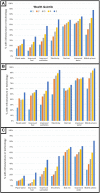Access to environmental health assets across wealth strata: Evidence from 41 low- and middle-income countries
- PMID: 30444899
- PMCID: PMC6239312
- DOI: 10.1371/journal.pone.0207339
Access to environmental health assets across wealth strata: Evidence from 41 low- and middle-income countries
Abstract
Introduction: Low levels of household access to basic environmental health assets (EHAs)-including technologies such as clean cookstoves and bed nets or infrastructure such as piped water and electricity-in low- and middle-income countries (LMICs) are known to contribute significantly to the global burden of disease. This low access persists despite decades of promotion of many low-cost, life-saving technologies, and is particularly pronounced among poor households. This study aims to characterize variation in access to EHAs among LMIC households as a function of wealth, as defined by ownership of various assets.
Methods: Demographic and Health Survey (DHS) data from 41 low- and middle-income countries were used to assess household-level access to the following EHAs: 1) improved water supply; 2) piped water supply; 3) improved sanitation; 4) modern cooking fuels; 5) electricity; and 6) bed nets. For comparison, we included access to mobile phones, which is considered a highly successful technology in terms of its penetration into poor households within LMICs. Ownership levels were compared across country-specific wealth quintiles constructed from household assets using bivariate analysis and multivariable linear regression models.
Results: Access to EHAs was low among the households in the bottom three quintiles of wealth. Access to piped water, modern cooking fuels, electricity and improved sanitation, for example, were all below 50% for households in the bottom three wealth quintiles. Access to certain EHAs such as improved water supply and bed nets increased only slowly with concomitant increases in wealth, while gaps in access to other EHAs varied to a greater degree by wealth quintile. For example, disparities in access between the richest and poorest quintiles were greatest for electricity and improved sanitation. Rural households in all wealth quintiles had much lower levels of access to EHAs, except for bed nets, relative to urban households.
Conclusions: The findings of this study provide a basis for understanding how EHAs are distributed among poor households in LMICs, elucidate where inequalities in access are particularly pronounced, and point to a need for strategies that better reach the poor, if the global environmental burden of disease is to be reduced.
Conflict of interest statement
The authors have declared that no competing interests exist.
Figures

Similar articles
-
Measuring disparities in sanitation access: does the measure matter?Trop Med Int Health. 2014 Jan;19(1):2-13. doi: 10.1111/tmi.12220. Trop Med Int Health. 2014. PMID: 24851256
-
Delivery channels and socioeconomic inequalities in coverage of reproductive, maternal, newborn, and child health interventions: analysis of 36 cross-sectional surveys in low-income and middle-income countries.Lancet Glob Health. 2021 Aug;9(8):e1101-e1109. doi: 10.1016/S2214-109X(21)00204-7. Epub 2021 May 26. Lancet Glob Health. 2021. PMID: 34051180 Free PMC article.
-
Household Determinants of Liquified Petroleum Gas (LPG) as a Cooking Fuel in South West Cameroon.Ecohealth. 2018 Dec;15(4):729-743. doi: 10.1007/s10393-018-1367-9. Epub 2018 Oct 1. Ecohealth. 2018. PMID: 30276494 Free PMC article.
-
The economics of healthcare access: a scoping review on the economic impact of healthcare access for vulnerable urban populations in low- and middle-income countries.Int J Equity Health. 2022 Dec 31;21(1):191. doi: 10.1186/s12939-022-01804-3. Int J Equity Health. 2022. PMID: 36585704 Free PMC article.
-
Using the Demographic Health Survey wealth index to create family planning market segments based on absolute income levels.BMJ Glob Health. 2020 Sep;5(9):e002450. doi: 10.1136/bmjgh-2020-002450. BMJ Glob Health. 2020. PMID: 32928799 Free PMC article. Review.
Cited by
-
A New Era for EHP's International Program.Environ Health Perspect. 2021 Jan;129(1):11001. doi: 10.1289/EHP8737. Epub 2021 Jan 5. Environ Health Perspect. 2021. PMID: 33400597 Free PMC article. No abstract available.
-
Disinfection of Neonatal Resuscitation Equipment in Resource-Limited Settings: Lessons From a Mixed-Methods Implementation Experience in Kenya.Glob Health Sci Pract. 2025 Aug 14;13(1):e2300398. doi: 10.9745/GHSP-D-23-00398. Print 2025 Aug 14. Glob Health Sci Pract. 2025. PMID: 40813241 Free PMC article.
-
Assessing the Impacts of Relative Wealth and Geospatial Factors on Water Access in Rural Nepal: A Community Case Study.Int J Environ Res Public Health. 2020 Sep 7;17(18):6517. doi: 10.3390/ijerph17186517. Int J Environ Res Public Health. 2020. PMID: 32906836 Free PMC article.
-
Monitoring Drinking Water Quality in Nationally Representative Household Surveys in Low- and Middle-Income Countries: Cross-Sectional Analysis of 27 Multiple Indicator Cluster Surveys 2014-2020.Environ Health Perspect. 2021 Sep;129(9):97010. doi: 10.1289/EHP8459. Epub 2021 Sep 21. Environ Health Perspect. 2021. PMID: 34546076 Free PMC article.
-
Progress in sanitation among poor households in Kenya: evidence from demographic and health surveys.BMC Public Health. 2019 Jan 31;19(1):135. doi: 10.1186/s12889-019-6459-0. BMC Public Health. 2019. PMID: 30704419 Free PMC article.
References
-
- Prüss-Üstün A, Corvalán C. Preventing disease through healthy environments Towards an estimate of the environmental burden of disease Geneva: World Health Organization; 2016.
-
- Walker CLF, Rudan I, Liu L, Nair H, Theodoratou E, Bhutta ZA, et al. Childhood Pneumonia and Diarrhoea 1 Global burden of childhood pneumonia and diarrhoea. Lancet. 2013;381(9875):1405–16. 10.1016/S0140-6736(13)60222-6 ISI:000317894800038. - DOI - PMC - PubMed
-
- Bonjour S, Adair-Rohani H, Wolf J, Bruce NG, Mehta S, Pruss-Ustun A, et al. Solid Fuel Use for Household Cooking: Country and Regional Estimates for 1980–2010. Environ Health Persp. 2013;121(7):784–90. 10.1289/ehp.1205987 ISI:000323711000016. - DOI - PMC - PubMed
-
- Hutton G. Global costs and benefits of reaching universal coverage of sanitation and drinking-water supply. J Water Health. 2013;11(1):1–12. 10.2166/wh.2012.105 ISI:000319500300001. - DOI - PubMed
MeSH terms
LinkOut - more resources
Full Text Sources

